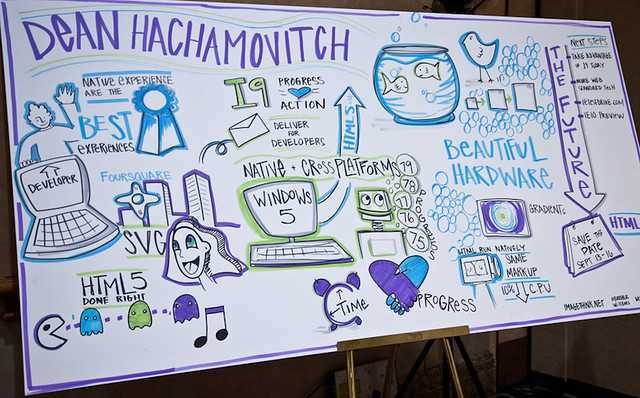IE’s future (and why is Silverlight still around?)
My formative years coincided with Microsoft’s Evil Empire phase — Slashdot had us convinced that the company was bent on total world domination and the enslavement of humanity. More recently, working as a web developer, my main interaction with Microsoft has been in making web sites compatible with old versions of Internet Explorer, a 2x multiplier on time estimates (and a 10x multiplier on frustration levels).
At MIX, Microsoft was in full atonement mode, acknowledging their mistakes of the past and assuring us that they’d changed. The conference’s first keynote was almost exclusively about IE and person after person spoke about Microsoft’s new commitment to openness and adhering to web standards. Just look at the key messages from the keynote, captured in mural form by Image Think:
- “Native is better”
- “Importance of HTML 5 keeps growing”
- “Developers deserve the best web”
- “Browsers that optimize for developers are better”
- “Built from the ground up”
And it wasn’t just talk — the recently-launched IE9 is a truly modern browser with a fast Javascript engine and much better CSS3 and HTML5 support.
Fellow-attendee, Morten Rand-Hendriksen agrees:
For anyone not working within or closely associated with the Microsoft universe the seemingly sudden shift to a focus on web standards, open source and interoperability may seem as a sudden and irratic shift. But it has actually been going on for a long time. It’s just that with the release of IE9 just a few weeks ago Microsoft suddenly went from being the reason why web standards and cutting edge web technologies couldn’t be implemented to a company leading the way and in many respects leaps and bounds ahead of the competition.
The first keynote set the tone but the rest of the conference was also full of sessions explaining IE’s future and how it’s aligned to web standards. In the Connect Lounge, the IE team set up laptops to view Beaty of the Web, a collection of cutting-edge sites that work just as well in other modern browsers. “Internet Explorer 9 was designed to let the potential of the web shine through,” says the site.
However… Silverlight
With all Microsoft’s talk of standards and openness recently, many thought this signalled the death of Silverlight, a proprietary browser plugin technology that seems to be mostly about replacing the equally-hated Flash. At MIX, we learned that Silverlight is quite definitely not dead — a new version was announced on the conference’s second day and Microsoft gave it unqualified support.
If the future of the web is about web standards, openness, and specifically, things like HTML 5 support, where does Silverlight fit in? Why did the Day 2 keynote feature a demo of a Silverlight-based site that could have almost certainly been developed without any proprietary plugin requirements?
(As an example of why Silverlight / browser plugins are easy to hate, here’s what happened the first time I went on the Silverlight-dependent site that archives the MIX videos: 1) I’m told I have to restart Firefox into 32-bit mode. 2) I did this and then got notified that I had to upgrade Silverlight. 3) I do this and reload the page — Firefox crashes. 4) About 10 minutes later, I was finally able to watch the video.)
Officially, prior to the conference, Microsoft gave a carefully-worded clarification of their position: in a nutshell, there are “different tools for different jobs.”
The Register’s Gavin Clarke has a theory:
It must keep those who answered their call and committed to Silverlight, while gently talking them down from the Silverlight heights and introducing them to HTML5. Microsoft cannot afford to see Silverlighters bolt en masse to HTML5 – or even return to Flash – so it must continue to explain ways in which Silverlight is better than HTML5 and why the player remains strategically important to the company.
But I also heard some other explanations:
- The division reflects a vicious internal political battle (IE under the Windows division vs. Silverlight under the Developer Tools division)
- Yes, Silverlight does similar things as HTML 5 but it’s a way of serving a different culture: the generation of application developers who are more comfortable doing web development with Silverlight/.NET than in than HTML/CSS/JS. In other words, the split is more about which developers to serve, rather than which users to serve.
- Silverlight’s actual importance is going to be for things like Windows Phone development.
The fact that Silverlight, a closed and proprietary technology, got almost as attention as the IE talk of open standards left a lot of us attendees confused and I don’t feel much was done to address this.
But regardless, as a web developer, I’m excited that there’s a very good chance that the process of spending countless hours making a site compatible with IE may become a thing of the past.
Some links to click on:
- Test Drive IE10
- Beautyoftheweb.com: Microsoft’s showcase of HTML 5 sites.
- SVG Girl: One of the more impressive demos that the IE team showed off at the MIX keynote




